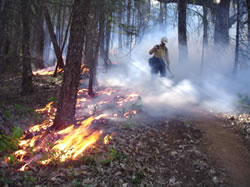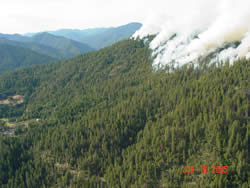
National Fire Plan Success Story
Happy Camp Fire Protection Phase 2
Happy Camp Ranger District, Klamath National Forest
National Fire Plan - Fuels Reduction
January 2008


Local fire crews, the Karuk tribal hand-crew, and fire engines from the Hoopa (tribal) Wildland Fire Department assisted with fire line preparation, pile burning, and the aerial and hand ignited prescribed burning.
The Happy Camp Fire Protection (HCFP) project is located in the lower Elk Creek drainage of the Happy Camp WUI defense zone, Klamath National Forest, California. The Elk Creek watershed is important to the local community in that it supplies the community with domestic water while also serving as a fire risk. The project is in the typical Klamath Mountain mixed conifer and hardwood vegetation type with known concentrations of lady's slipper orchids. This project was designed to reduce fine fuel accumulation and consequent fire hazard to the community and adjacent private properties, improve forest health and return fire to a fire-adapted ecosystem.
The project included understory thinning and hand piling followed with prescribed burning. The Happy Camp Fire Safe Council and personnel from the Karuk tribe of California Natural Resource Department collaborated in the planning of the community fire protection strategy to implement this project. Local fire crews, the Karuk tribal hand-crew, and fire engines from the Hoopa (tribal) Wildland Fire Department assisted with fire line preparation, pile burning, and the aerial and hand ignited prescribed burning. Other collaborators included adjacent private landowners who participated in Wyden Amendment agreements to allow use of tactical and effective holding features on their property during the underburn. Forest botanist joined the collaboration process to reduce fire effects and impacts to threatened and endangered species.
The final implementation of this project will have reduced fuel accumulations and restored fire to the landscape in an area that has a history of lightning and arson fires. It is also directly adjacent to local FireSafe thinning projects that were planned as a collaborative addition to the HCFP strategy and carries fuel treatments up the drainage to the site of a 1999 project wildfire effectively buffering private property on the east side of Elk Creek. This area was not directly affected by 2007 wildfires but other FireSafe projects within the community collaboration were used as holding features.
Contract crews began thinning in late 2003-early 2004, and local crews started line prep in 2004. Different phases of underburning began in June 2005 and continued through 2007. The district hopes to complete the last portion of burning in the fall of 2008.
Contact: Susan Daniels, sdaniels@fs.fed.us, or (530) 493-1716